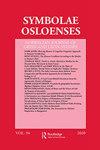Δια as a Polysemous Preposition in Early Byzantine Greek: “Dead Ends” and Other Uses in the Qurrah Archive (VIII AD)
IF 0.1
3区 历史学
0 CLASSICS
引用次数: 1
Abstract
In this article, I offer a systematic description of the various uses of the preposition διά in the Early Byzantine archive of Qurrah ibn Sharik (VIII AD), an archive in which the preposition is attested remarkably frequently. Functionally, the use of διά is reminiscent of the Classical period, in that various older uses are attested that no longer occur in Modern Greek (such as PATH, INTERMEDIARY, and INSTRUMENT). However, there are also various innovative uses that are attested neither in the Classical nor in the Modern period (such as AGENT, SOURCE, and OPPONENT). The occurrence of these “dead ends” shows that the functional development of prepositions from Classical to Modern Greek should not be thought of as linear.Δια作为拜占庭早期希腊语中的一个多义词介词:《古兰经》档案中的“死胡同”和其他用途(公元八年)
在这篇文章中,我提供了一个系统的描述,在古拉伊本沙里克(公元八世纪)的早期拜占庭档案中,介词的各种用法,在这个档案中,介词被证明是非常频繁的。在功能上,διά的用法让人联想到古典时期,因为在现代希腊语中已不再出现各种较旧的用法(如PATH, INTERMEDIARY和INSTRUMENT)。然而,也有各种各样的创新用途,既没有在古典时期也没有在现代时期得到证实(如AGENT、SOURCE和OPPONENT)。这些“死胡同”的出现表明,介词从古典希腊语到现代希腊语的功能发展不应该被认为是线性的。
本文章由计算机程序翻译,如有差异,请以英文原文为准。
求助全文
约1分钟内获得全文
求助全文

 求助内容:
求助内容: 应助结果提醒方式:
应助结果提醒方式:


